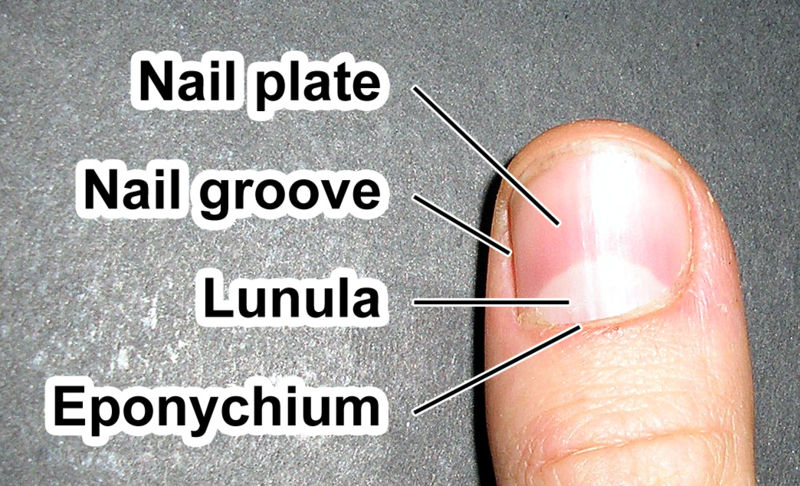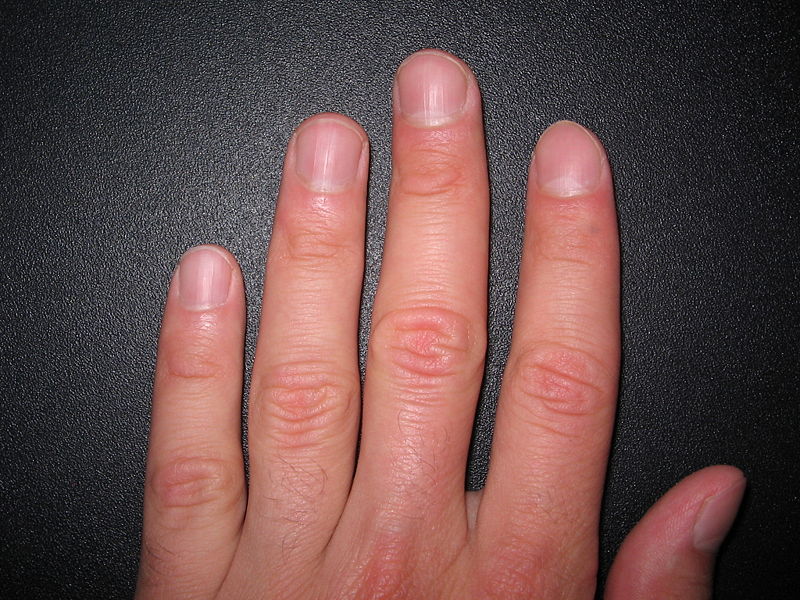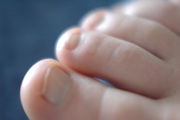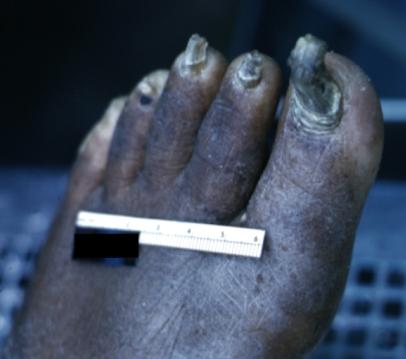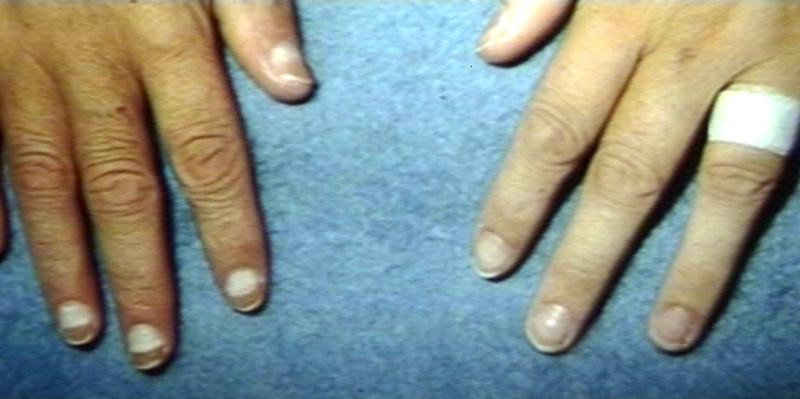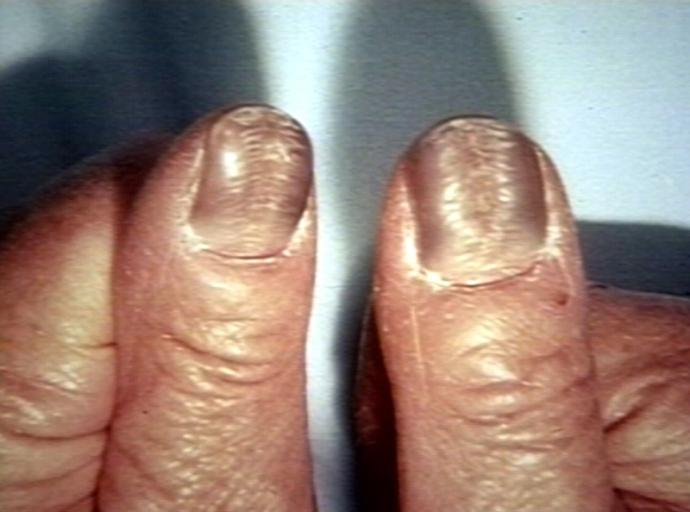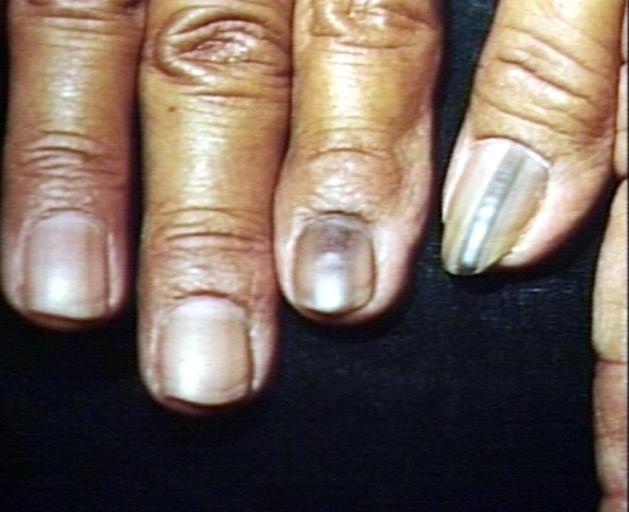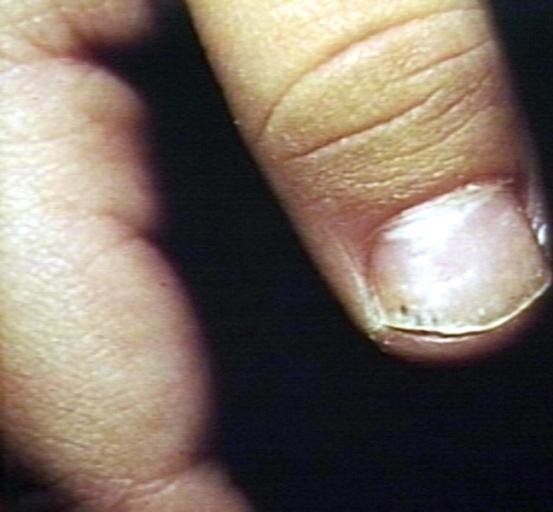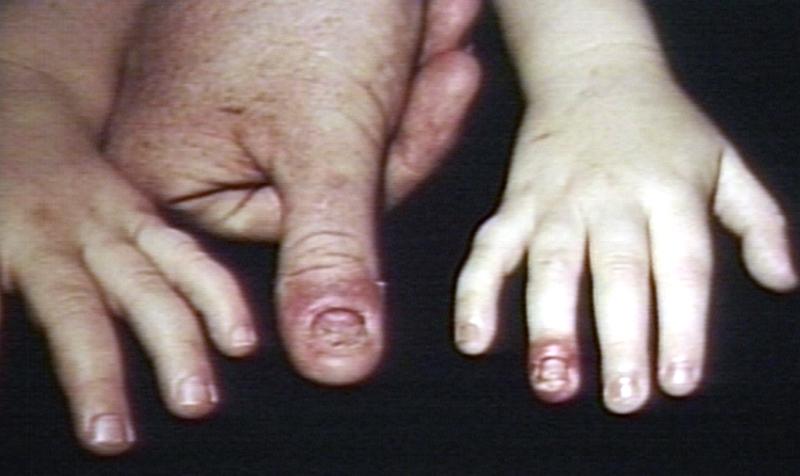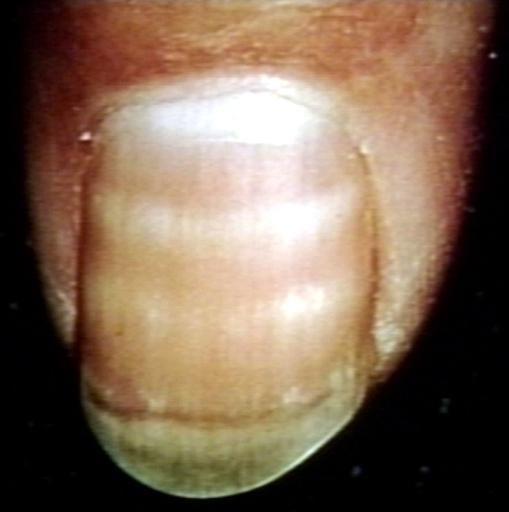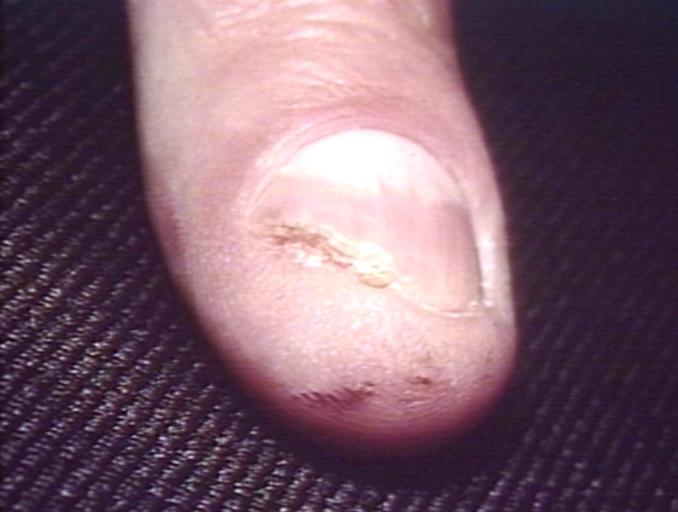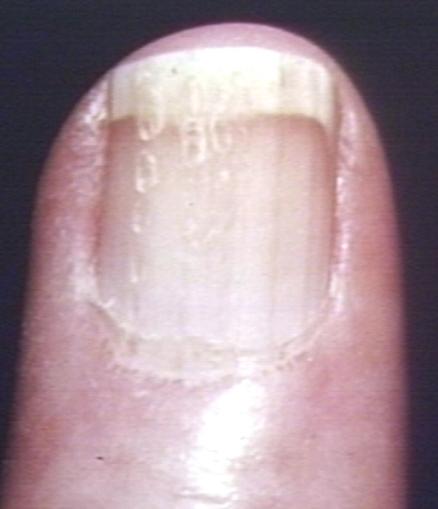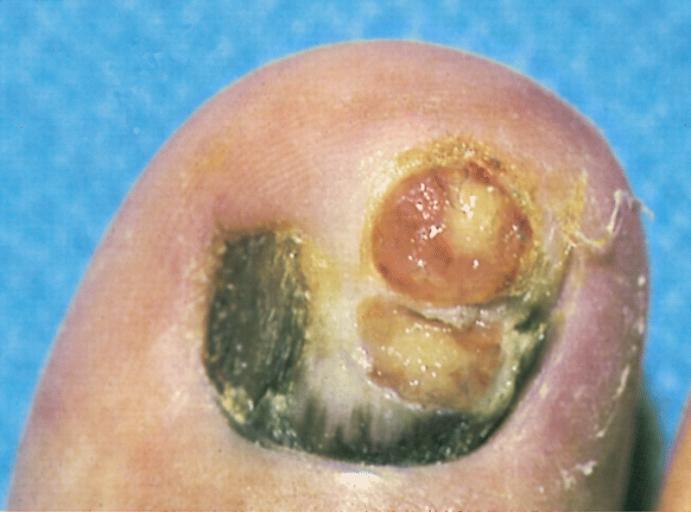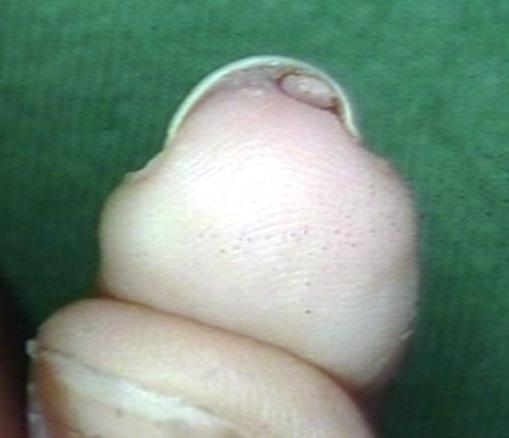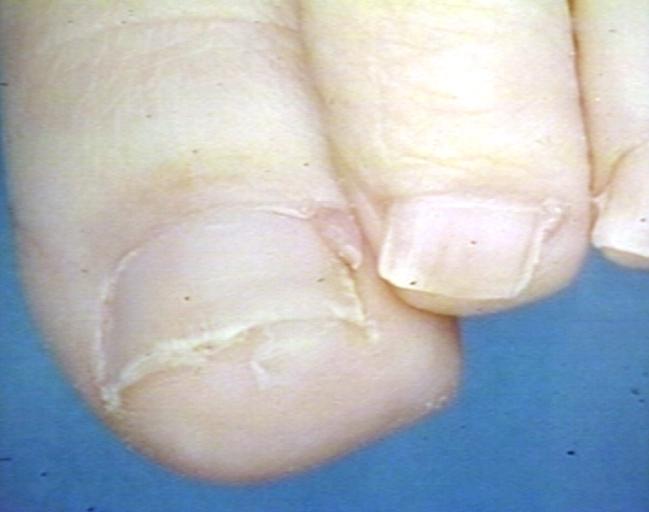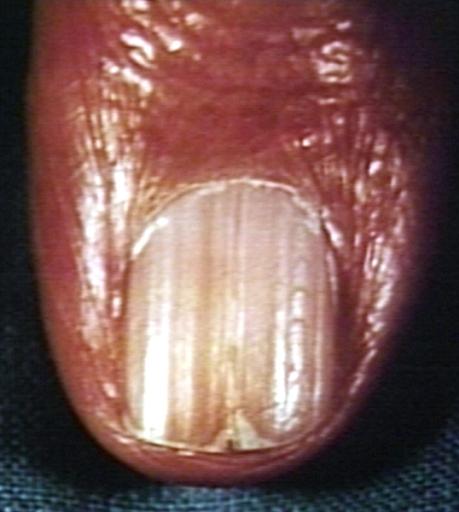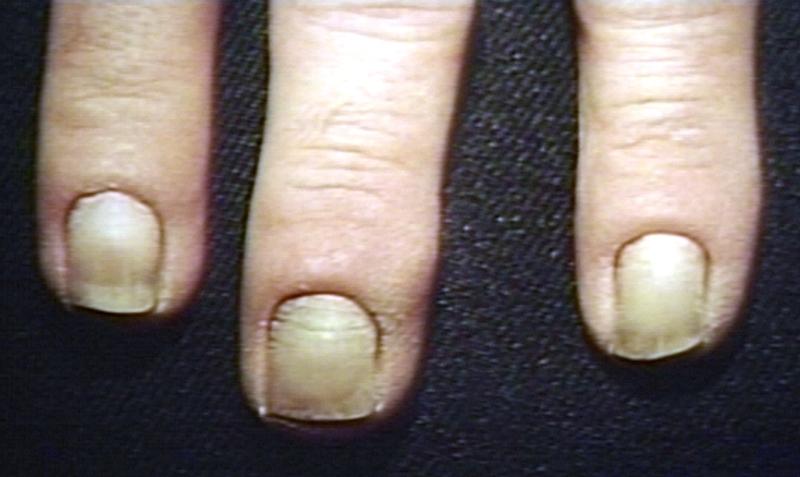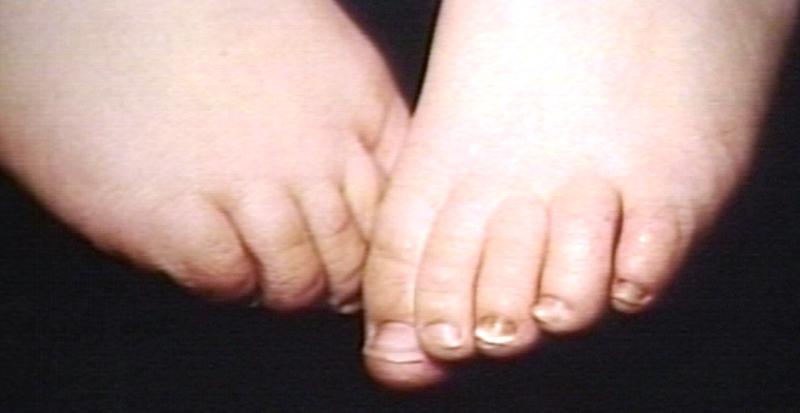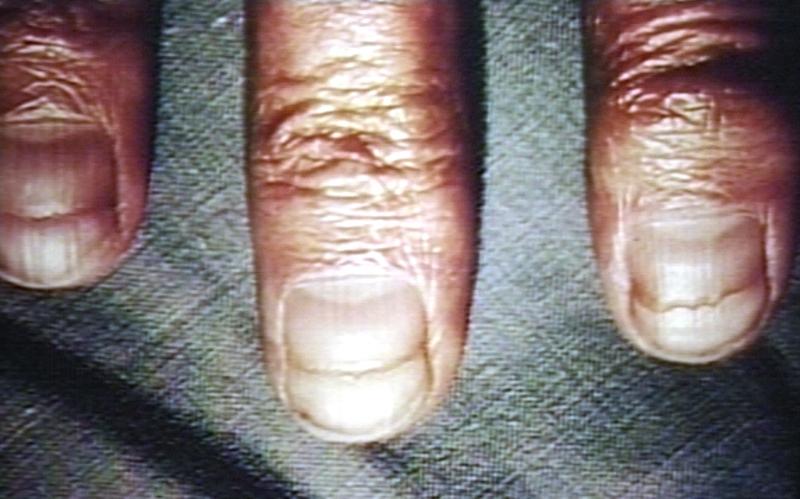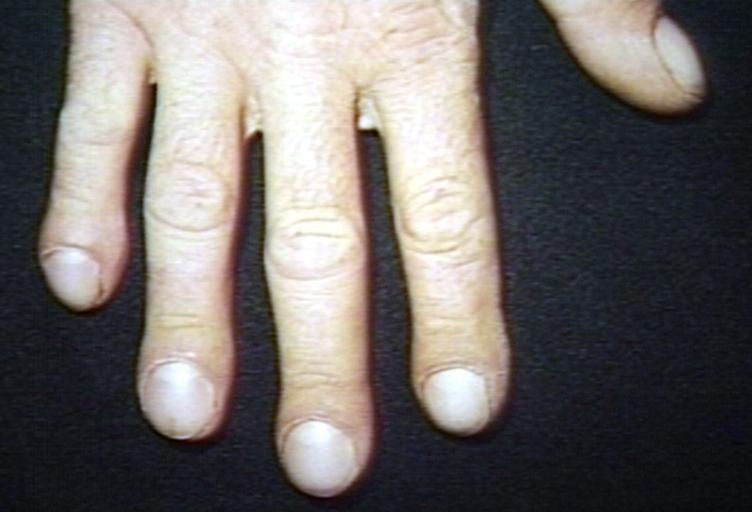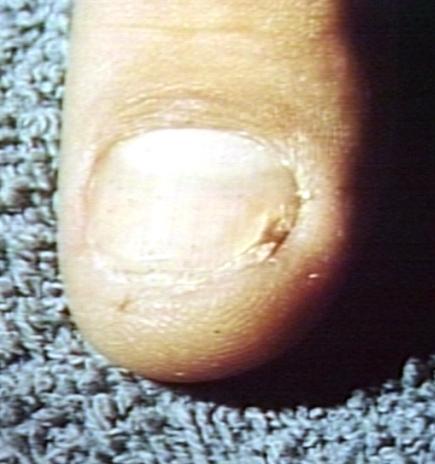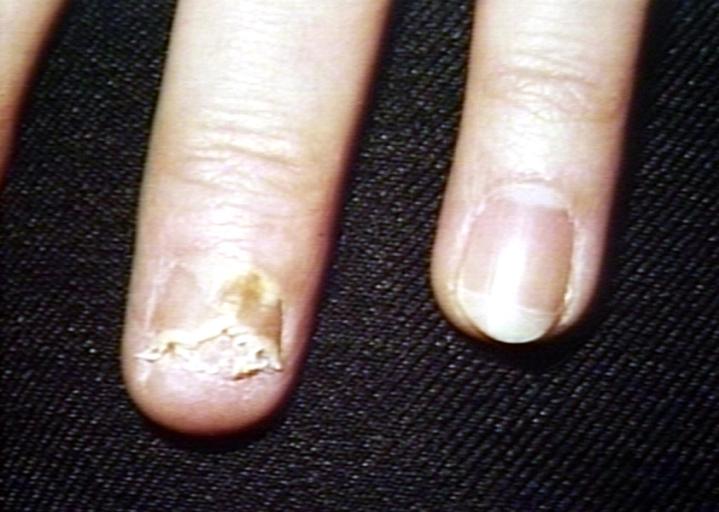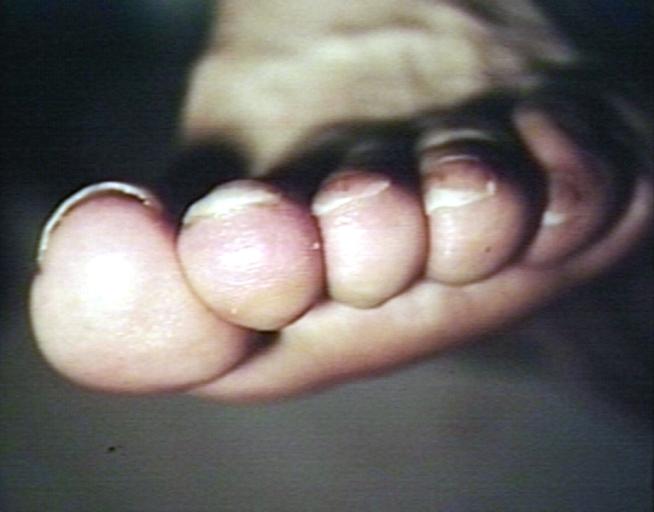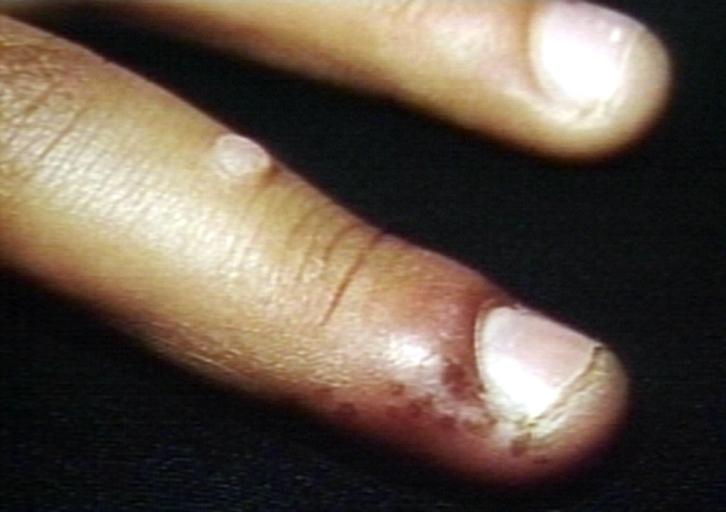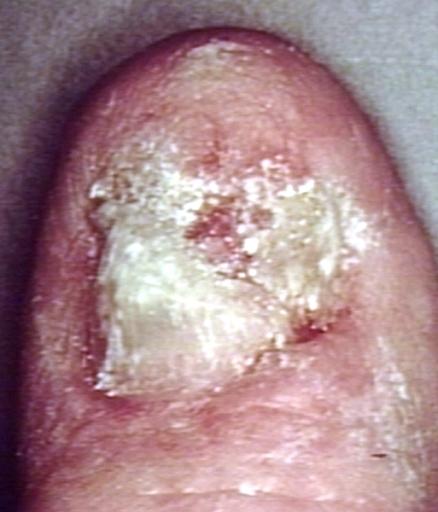Nail changes
Template:DiseaseDisorder infobox Editor-In-Chief: C. Michael Gibson, M.S., M.D. [2]; Associate Editor-In-Chief: Cafer Zorkun, M.D., Ph.D. [3]
Synonyms and keywords: nail abnormality, nail disorders, nail signs
Overview
Nail diseases are distinct from diseases of the skin. Although nails are a skin appendage, they have their own signs and symptoms which may relate to other medical conditions. Nail conditions that show signs of infection or inflammation require medical assistance and cannot be treated at a beauty parlor. Deformity or disease of the nails may be referred to as onychosis.
Classification Scheme

Acrocyanosis
Doctor definition: Acrocyanosis is a persistent blue or cyanotic discoloration of the digits.
Patient definition: Acrocyanosis is a blue discoloration of the fingers and the fingernails.
---
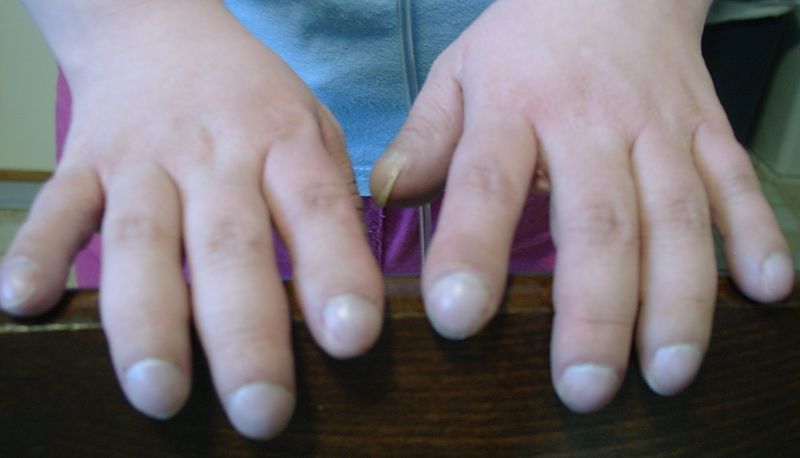
Digital clubbing
Doctor definition: Digital clubbing is a deformity of the fingers and fingernails that is associated with a number of diseases, mostly of the heart and lungs.
Patient definition: Digital clubbing is a deformity of the fingers and fingernails that is associated with a number of diseases, mostly of the heart and lungs.
---
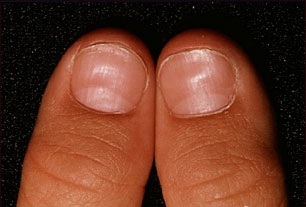
Koilonychia
Doctor definition: Koilonychia refers to nails (usually of the hand) which have lost their convexity, becoming flat or even concave in shape.
Patient defintion: Koilonychia literally means spoon nails. It is when your nails become flat or sunken in.
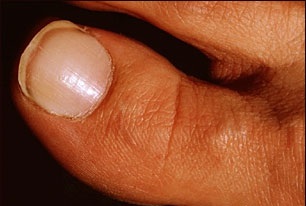
Leukonychia
Doctor definition: Leukonychia is a medical term for white discoloration appearing on nails.
Patient defintion: Leukonychia is a medical term for white discoloration appearing on nails.
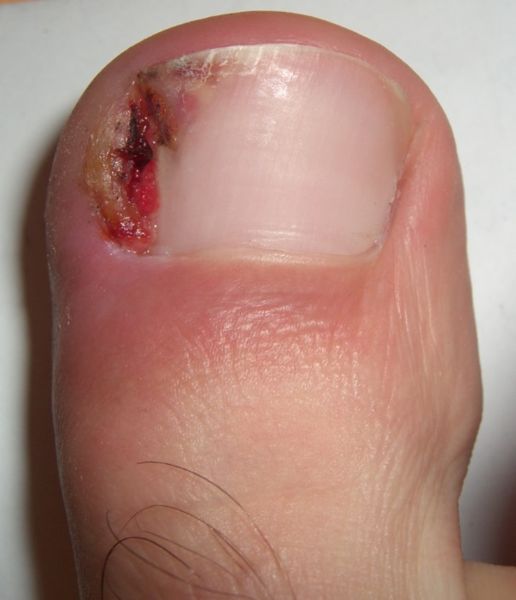
Onychocryptosis
Doctor definition: Onychocryptosis is a painful condition in which the nail grows or cuts into one or both sides of the nail bed.
Patient defintion: Onychocryptosis is a painful condition in which the nail grows or cuts into one or both sides of the nail bed.
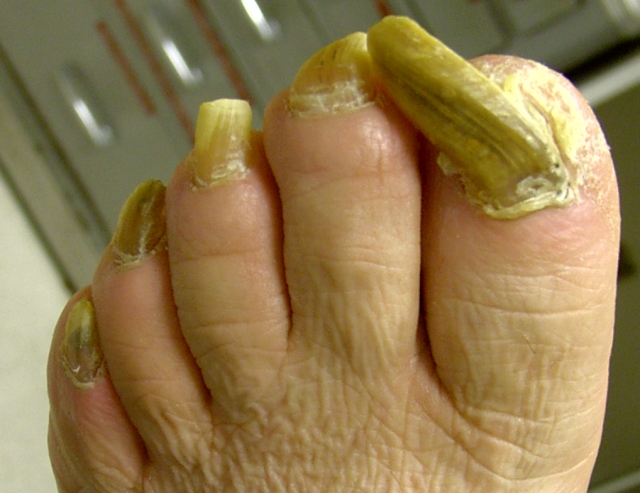
Onychogryphosis
Doctor definition: Onychogryposis, also called "ram's-horn nail", is a thickening and increase in curvature of the nail.
Patient definition: Onychogryposis, also called "ram's-horn nail", is a thickening and increase in curvature of the nail.
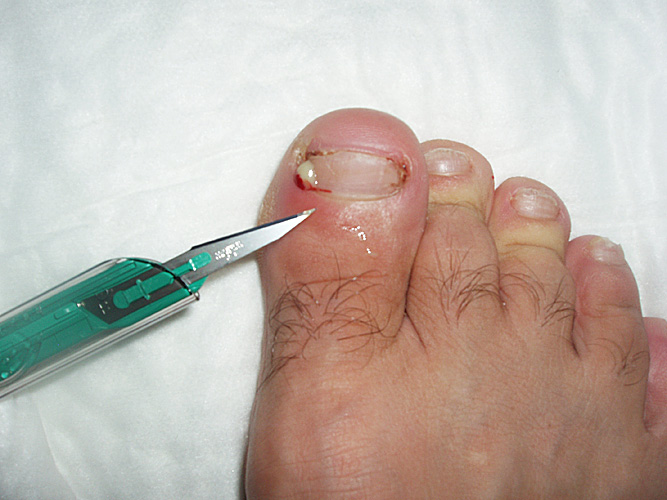
Paronychia
Doctor defintion: Paronychia is an often tender bacterial or fungal infection where the nail and skin meet at the side or the base of a finger or toenail.
Patient definition: Paronychia is an often tender infection where the nail and skin meet at the side or the base of a finger or toenail.
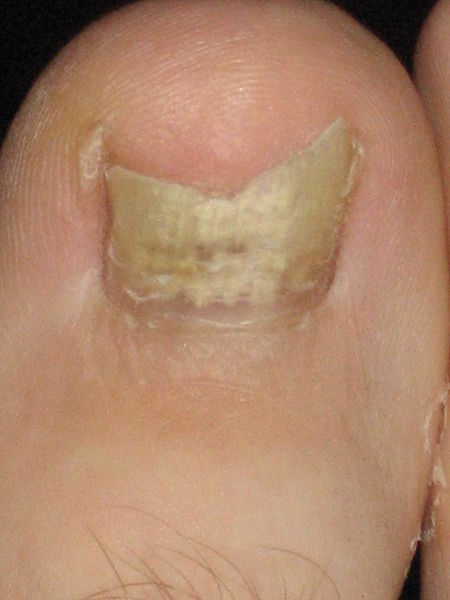
Onychomycosis
Doctor definition: Onychomycosis is a fungal infection of the nails.
Patient definition: Onychomycosis is a fungal infection of the nails.
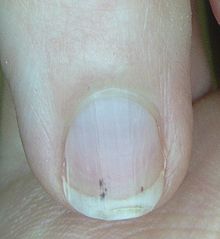
Splinter hemorrhage
Doctor defintion: Splinter hemorrhages are tiny lines that run vertically under the nails.
Patient definition: Splinter hemorrhages are tiny lines that run vertically under the nails.
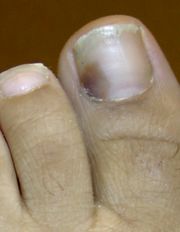
Subungual hematoma
Doctor definition: A subungal hematoma is a hematoma underneath a toenail or fingernail which often results from a traumatic injury such as slamming a finger in a door.
Patient definition: A subungal hematoma is a collection of blood underneath a toenail or fingernail which often results from a traumatic injury such as slamming a finger in a door.
Beau lines
Nail discoloration
Nail pitting
Onycholysis
Onychorrhexis
Pachyonychia
Platonychia
Ridged nails
Subungual hyperkeratosis
Diseases
- Onychia is an inflammation of the matrix (surrounding tissue) of the nail with formation of pus and shedding of the nail. Onychia results from the introduction of microscopic pathogens through small wounds.
- Onychodystrophy is a deformation of the nails that can result from cancer chemotherapy which includes bleomycin, hydroxyurea, or 5-fluorouracil. It can include discoloration of the nail, or dyschromia.
- Onychogryposis, also called "ram's-horn nail", is a thickening and increase in curvature of the nail. It is usually the result of injury to the matrix. It may be partially hereditary and can also occur as a result of long-term neglect. It is most commonly seen in the great toe but may be seen in other toes as well as the fingernails. An affected nail has many grooves and ridges, is brownish in color, and grows more quickly on one side than on the other. The thick curved nail is difficult to cut, and often remains untrimmed, exacerbating the problem.
- Onycholysis is a loosening of the exposed portion of the nail from the nail bed, usually beginning at the free edge and continuing to the lunula. It is frequently associated with an internal disorder, trauma, infection, nail fungi, allergy to nail enhancement products, or side effects of drugs.
- Onychomadesis is the separation and falling off of a nail from the nail bed. Common causes include localized infection, minor injury to the matrix bed, or severe systemic illness. It is sometimes a side effect of chemotherapy or x-ray treatments for cancer. A new nail plate will form once the cause of the disease is removed.
- Onychomycosis, also known as tinea unguium, is a contagious infection of the nail caused by the same fungal organisms which cause ringworm of the skin (Trichophyton rubrum or T. mentagrophytes, rarely other trichophyton species or Epidermophyton floccosum [1]). It can result in discoloration, thickening, chalkiness, or crumbling of the nails and is often treated by powerful oral medications which, rarely, can cause severe side effects including liver failure. Mild onychomycosis sometimes responds to a combination of topical antifungal medication, sometimes applied as special medicinal nail lacquer, and periodic filing of the nail surface. For advanced onychomycosis, especially if more than one nail is infected, systemic medication (pills) is preferred. Home remedies are often used, although their effectiveness is disputed. In a study at the University of Rochester tea tree oil applied twice daily in conjunction with debridement was found to be an appropriate initial treatment strategy, equally effective to topical use of clotrimazole[2]. Another procedure is to apply two drops of distilled white vinegar to the nail base, or, additionally, nail plate and under the nail, two or three times daily for approximately six months or until the fungus is gone. This treatment is very effective, due to the vinegar's acidity, if followed consistently.
- Onychophosis is a growth of horny epithelium in the nail.
- Onychoptosis is the periodic shedding of one or more nails, in whole or part. This condition may follow certain diseases such as syphilis, or can result from fever, trauma, systemic upsets or adverse reaction to drugs.
- Paronychia is a bacterial or fungal infection where the nail and skin meet.
- Koilonychia is when the nail curves upwards (becomes spoon-shaped) due to an iron deficiency. The normal process of change is: brittle nails, straight nails, spoon-shaped nails.
- Subungual hematoma occurs when trauma to the nail results in a collection of blood, or hematoma, under the nail. It may result from an acute injury or from repeated minor trauma such as running in undersized shoes. Acute subungual hematomas are quite painful, and are usually treated by releasing the blood by creating a small hole in the nail. Drilling and thermal cautery (melting) are common methods for creating the hole. Thermal cautery is not used on acrylic nails because they are flammable.
Associated Conditions with Nail Changes
Nail inspection can give a great deal of information about the internal working of the body as well, and like tongue or iris inspection, has a long history of diagnostic use in traditional medical practices such as Chinese medicine.
Pliability:
- Brittleness is associated with iron deficiency, thyroid problems,[3] impaired kidney function, circulation problems, and biotin deficiency[2]
- Splitting and fraying are associated with psoriasis and deficiencies of folic acid, protein and Vitamin C.
- Unusual thickness is associated with circulation problems.
- Thinning nails and itchy skin are associated with lichen planus[4].
Shape and texture:
- Clubbing, or nails that curve down around the fingertips with nailbeds that bulge is associated with oxygen deprivation and lung, heart, or liver disease.
- Spooning, or nails that grow upwards is associated with iron or B12 deficiency.
- Flatness can indicate a B12 vitamin deficiency[4] or Raynaud's disease[5]
- Pitting of the nails is associated with Psoriasis.
- Ridges across the nail indicate stress.
- Beau's lines across the nail are associated with many serious conditions.
- Ridges along the nail are associated with arthritis[2].
- Grooves along the nail are associated with kidney disorders, aging, and iron deficiency[2].
- Beading is associated with rheumatoid arthritis[2].
- Nails that resemble hammered brass are associated with (or portend) hair loss[4].
- Short small beds are associated with heart disease.
Coloration of the nail bed:
- Mee's lines are associated with arsenic or thallium poisoning, and renal failure.
- White lines across the nail are associated with heart disease, liver disease, or a history of a recent high fever[4].
- Opaque white nails with a dark band at the fingertip are associated with cancer, cirrhosis, congestive heart failure, diabetes and aging[4].
- Paleness or whitening is associated with liver or kidney disease and anemia[4].
- Yellowing of the nail bed is associated with chronic bronchitis, lymphatic problems, diabetes, and liver disorders.
- Brown or copper nail beds are associated with arsenic or copper poisoning, and local fungal infection.
- Grey nail beds are associated with arthritis, edema, malnutrition, post-operative effects, glaucoma and cardio-pulmonary disease.
- Redness is associated with heart conditions.
- Dark nails are associated with B12 deficiency.
- Stains of the nail plate (not the nail bed) are associated with nail polish[2], smoking, and henna use.
Markings:
- Pink and white nails are associated with kidney disease[4].
- Muehrcke's lines are white lines across the nail associated with hypoalbuminemia.
- Red skin at the base of the nail is associated with connective tissue disorders[4].
- Blue lunulae are associated with silver poisoning or lung disorder[4].
- Blue nail beds are (much like blue skin) associated with poor oxygenation of the blood (asthma, emphysema, etc)[4].
- Small white patches are associated with zinc or calcium deficiency or malabsorption, parasites, or local injury[5].
- Receded lunulae (fewer than 8) are associated with poor circulation[5], shallow breathing habits or thyroid mysfunction[4].
- Large lunulae (more than 25% of the thumb nail) are associated with high blood pressure.
Diagnosis
History and Symptoms
- History of psoriasis
- Family history
- Occupational history
- Hobbies
Physical Examination
- Complete skin exam
Laboratory Studies
- Periodic Acid-Schiff (PAS)
- Fungal cultures
- Bacterial cultures
Other Diagnostic Studies
- Nail matrix biopsy
- Possible dermatology referral
Differential Diagnosis of Causes of Nail changes
Beau's Lines
Transverse furrows, sign of a previous arrest in the growth process
- Coronary occlusion
- Delirium
- Depression
- Gout
- Malnutrition
- Reiter's Disease
- Severe infectious disease
- Shock
- Surgery
- Toxins
- Trauma
- Traumatic damage to nail matrix
Blue discoloration
Brown-black discoloration
Green-black discoloration
Half and Half Nails
White (proximal) and brown (distal) reversible coloration of the nail
Hippocratic Nails
Large, curved nails that usually occur in conjunction with clubbing
- Arteriovenous shunts
- Biliary Cirrhosis
- Bronchiectasis
- Bronchial carcinoma
- Cerebrovascular trauma
- Cyanotic congenital heart disease
- Crohn's Disease
- Emphysema
- Heart Failure
- Infectious Endocarditis
- Liver Tumors
- Lung Abscess
- Mesothelioma
- Pachydermoperiostosis
- Pulmonary artery sclerosis
- Pulmonary fibrosis
- Pulmonary metastases
- Silicosis
- Sprue
- Tuberculosis
- Ulcerative Colitis
Koilonychia
A malformation of the nails which the outer surface is concave
- Addison's Disease
- Cushing's Disease
- Diabetes Mellitus
- Grave's Disease
- Hereditary
- Hypochromic anemia
- Iron deficiency
- Malnutrition
- Multiple Myeloma
- Pellagra
- Raynaud's disease
- Vitamin B12 Deficiency
Leukonychia
White coloration of nails
- Anemia
- Cardiac Diseases
- Cirrhosis
- Darier's disease
- Fever
- Hypoalbuminemia
- Mycosis
- Nitrate solution
- Silver solution
- Noxa
- Trauma
Mee's Lines
Horizontal white bands of the nails
Onychogryphosis
Brittle, Split nails
- Anemia
- Chronic chemical damage
- Lichen ruber
- Thyroid Disease
Onchodystrophy
Deformed, brittle, rough, discolored nails
Onycholysis
Painless loss of the nail
- Circulatory system diseases
- Diabetes Insipidus
- Diabetes Mellitus
- Drugs
- Eczema
- Hemangioma under the nail
- Onychomycosis
- Psoriasis
- Reiter's Disease
- Thyroid Disease
- Tumor
Paronychia
Inflammation of the nail bed
Pitted Nails
Pinpoint depressions in the nails
Yellow nails
Yellow-greenish discoloration of the nails (some or all) with subsequent onycholysis
- Congenital hypoplasia / dysplasia of peripheral lymph vessels
- Diseases of the bronchial tubes
- Diseases of the paranasal sinuses
- Smoker's fingers
Pathological Findings
-
Acrocyanosis: Gross, an excellent example of cyanotic nail beds.
-
Trophic Changes: Gross natural color distorted nails and thick skin typical of chronic ischemia
-
Renal failure, chronic with nail changes; half and half nails. Left hand more typical. Unusual asymmetrical
-
Hydroxyurea Nails; Nail changes associated with Hydroxyurea therapy in a patient with essential thrombocythemia.
-
Nail disease, brown banding
-
Nail disease, secondary to psoriasis
-
Paronychia due to Candida; nail diseases
-
Nail disease; white banding
-
Nail: Bowen's carcinoma
-
Nail changes in Scleroderma. Posterior nail fold.
-
This is a subungual radial growth phase of acral-lentiginous type with two amelanotic vertical growth phase tumor nodules. Radial growth phase is just beginning to grow onto the cuticle of the nail, displaying a subtle example of "Hutchinson's sign."
-
Tuberous sclerosis; Subungual fibroma; Beneath the Left Index Nail
-
Tuberous sclerosis, Periungual Fibroma; Lateral Side of Left Great Toe Nail
-
Traumatic nail changes
Treatment
Acute Pharmacotherapies
- Systemic antifungals
- Intralesional steroids
- Topical paint-on ciclopirox
- Systemic antipsoriatic therapies
References
- ↑ Hall, John C. (2006). "25. Dermatologic mycology.". In John C. Hall. Sauer's Manual of Skin Diseases (9th edition ed.). Philadelphia: Lippincott Williams & Wilkins. pp. 244=266. ISBN 0-7817-2947-5.
- ↑ 2.0 2.1 2.2 2.3 2.4 2.5 [1].
- ↑ http://www.bhcs.com/healthinformation/baylorhealthmagazine/2005/nov/AS_thyroid.htm
- ↑ 4.00 4.01 4.02 4.03 4.04 4.05 4.06 4.07 4.08 4.09 4.10 Judith Cobb, Fingernails, Jewels or Tools? Nature's Field - Nail diagnosis]
- ↑ 5.0 5.1 5.2 Mariann Cade, Fingernails - Diagnostic Tool
See also
- Leukonychia
- Mee's lines
- Beau's lines
- Occupational hazards associated with exposure to human nail dust
External links
- Ingrown Toenail - explanation covering causes, treatment, and prevention (with diagram)
- Links to pictures of Nail Diseases (Hardin MD/Univ of Iowa)
- How Fingernail Fungus Spreads, and How to Treat It a practical guide for the layman.
- Nail Abnormalities: Clues to Systemic Disease
